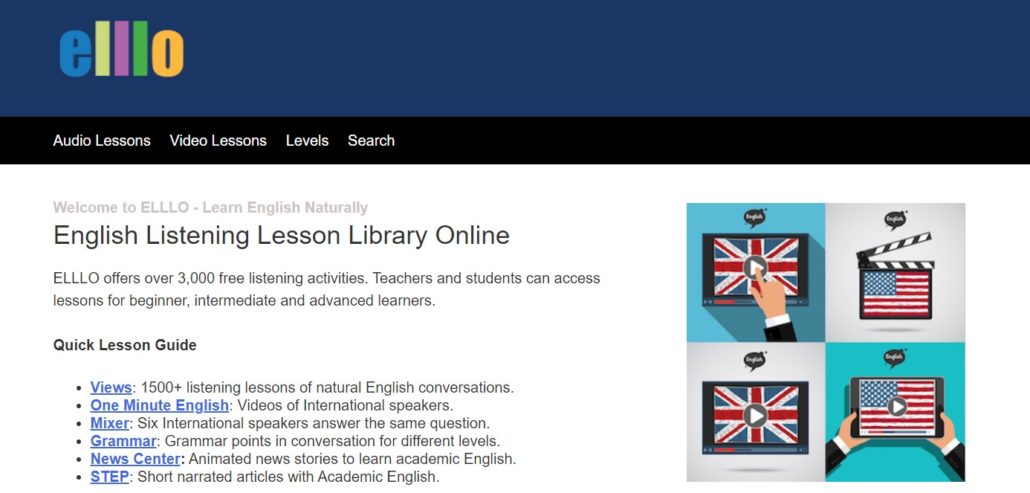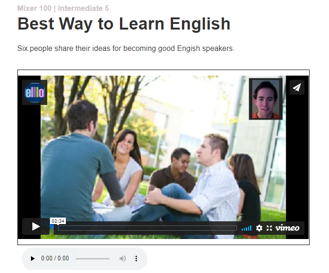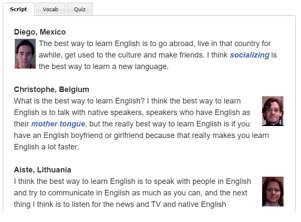As teaching listening classes can be challenging, especially when you’re not sure how to do it. Sure, you can follow traditional listen and repeat exercises. Alternatively, you can incorporate modern materials such as YouTube videos or songs into your lessons.
They each have their place and are pretty much the standard activities for listening classes. But today we’re going to show you something different—a website you can access to create engaging listening lessons.
We’re referring to the ELLLO website, elllo.org. ELLLO stands for English Listening Lesson Library Online. It’s a great website I discovered many years ago while teaching English in Korea.
It was created by a career ESL teacher in Japan named Todd Beuckens. And, in my opinion, it’s brilliant. Best of all, the materials are free!
When you first arrive on the site you might be overwhelmed by the possibilities. As such, there are several types of lessons to choose from: Views, One-Minute English, Mixers, Grammar, News Center, and STEP activities.
Plus, if you scroll down the page, there are even more activities posted.
There are so many options to choose from. But we’re going to help you with that. So, to keep things simple and to fit the limitations of this blog, we’ll address just one of these—Mixers.
Get the Best Teaching English Jobs in South Korea
Mixers
At the top of the home page, you’ll find a list of options for listening activities/exercises they refer to as a quick lesson guide.

If you scroll down the page, as mentioned, you might be overwhelmed by everything else. So, let’s just start with the Mixers for now.
The mixers are recordings of six people answering one question. There are literally 1500+ Mixers to choose from. They cover a plethora of topics from shopping, learning English, family life, flying, business ideas, and much, much more.
As an added bonus, many of these are non-native English speakers from different countries, not just native English speakers. So, in today’s global environment, this can help expose learners to different accents and dialects of English.
If you click on any one of these mixers, you’ll be brought to the Mixer page. Here you will find a .mp3 recording of 6 people answering a question. You’ll also notice vocabulary helps, transcripts, quizzes, and comprehension questions available.

You might be thinking that this is something students can do on their own, and you’re right. But, as a teacher, you can give these lessons much more life.
How? By being there to help with nuance, vocabulary use, structure, and more. Plus, these mixers can be the very prompts you need to engage learners in meaningful conversations.
Read: TESOL: How to Teach Listening Skills
How Do You Use a Mixer to Teach?
It all seems pretty straightforward you may be thinking. Just play the recordings and listen to what’s being said. Then follow the transcripts if need be. Look at the vocabulary, and take a quiz, right?
Well, yes and no. That’s the safe way to play it. And it might be something you suggest learners do at home. But, there’s more to it than that. So, let’s look at how you can manage a Mixer lesson in a way that keeps learners active and engaged.
An ELLLO Mixer Lesson

- Always be sure the topic is something your class members are interested in.
- Arrange learners so they’re all able to hear the audio clearly. If available, arrange them so they can see a computer or projector screen also.
- Try to use sound equipment that is as clear as possible. You may even need to tweak your computer audio settings.
- Initially, do not let your students see the transcripts.
- Play the recording having class members listen or listen and take notes. I think it’s much better without the notes. We don’t usually do that in life.
- After each answer, pause the recording and ask the students the gist of the answer. What I like to do, if possible, is type student responses in a document so students can go back and review what they said compared to what was said.
- Allow students to tell you what they heard. Sometimes they’re right on, sometimes they’re not. But these are learning opportunities for them and teaching moments for you.
- Now, show the learners the transcript and repeat the audio answer while they follow along.
- Learners are now able to see (and hear) what they picked up and what they didn’t. At times, that may mean specific words or general ideas.
- Go over the transcript, vocabulary, idiom, structure, etc. with your learners. Warning: Sometimes, the speakers (both native- and non-native) do not use accurate words or structure. This too becomes an opportunity to teach. See ‘Additional Benefits’ below for further explanation.
- Go to the next recording. Repeat items 4–10 above for each.
- You can skip some of the more difficult responses and stay with maybe three of the six for the lesson. I find that if you try to squeeze in all six, you won’t have time for all of the activities in a typical 50-minute class session.
- Once you finish the recordings, it’s time to talk.
- Each student has now heard at least three responses to the same question. They’ve learned possible vocabulary and structure. They’ve even gotten ideas about how someone else feels that’s similar to their own ideas. They’re ready now to answer the question.
- Engage in guided conversation around the practical Mixer questions, and you will likely have more confident speakers as a result.
- Wrap up the lesson with feedback. Anonymously point out any prevalent grammar, lexical, or pronunciation challenges from the class.
- Congratulations! You’ve just completed a multi-faceted ESL multivitamin and mineral lesson!
Read: How To Teach Listening Skills
Additional Benefits
Listening is not simply the act of hearing sounds. It involves understanding (or decoding) words and phrases to discern the intended meaning. As such, you don’t have to treat this class as simply listening to words in isolation.
That’s because there are other activities involved. As such, listeners must also understand the structure (grammar) of what they’re hearing and the vocabulary, then be able to put it all together.
Grammar in Use
Mixers provide an excellent opportunity to point out natural grammar in use. Why? Because these answers are not scripted. The people speaking are sharing their thoughts impromptu.
As a result, they’re going to use certain structures such as past, present, or future verb tenses, conditionals, or other grammar forms. And they may likely make mistakes as well.
You can ask learners if they caught anything grammatically ‘off’ in the answers. Or, you can ask them to use the same forms in creating their own answers. There are multiple options available to creative teachers. I’ve only given you a couple of ideas. Let your creativity kick in and you might just think of more.
Read: How to Teach English Grammar with Songs!
Vocabulary in Use
Most importantly, just as impromptu answers come with various structures, so too they come with a variety of vocabulary. Be prepared with your dictionary, as at times, some of the responses include vocabulary that even you may not be familiar with.
Nevertheless, Mixer answers offer a great way of learning new vocabulary for learners. On top of that, it’s not random vocabulary, but language that answers specific questions.
This offers context for the vocabulary. As such, it provides scaffolding for future lessons with similar ideas.
Top-Down or Bottom-Up Approach?
We’ll address the Top-Down and Bottom-Up approaches to ESL listening lessons in a future blog. However, the question some teachers may be asking, is do I teach the lesson and require them to pick out words (Bottom-Up)?
Or should I manage the lessons so that I can challenge learners to understand concepts or act on the information communicated (Top-Down)? Do you want learners to focus on specific words or speech sounds, or do you want them to be able to explain meaning?
As mentioned, we’ll discuss the merits and or demerits of each approach in an upcoming blog. However, for right now, you should decide what you think is more important and stay with it throughout the lesson.
-Learn to teach listening lessons with an accredited online TESOL certification course-
Closing Comments
You can download Mixers and Views as well as the audio files. Then, copy the transcripts, vocabulary, and quizzes. Finally, except for the audio file, everything can be neatly arranged in a Word document and printed (or not if an e-classroom) for use in your listening class.
You now have lessons free from ELLLO.org. It’s up to you to make them work. Not only that but with 1500+ lessons, you have a wide range of topics to choose from and a reserve of lessons to keep listening classes going for some time ahead.
However, please be sure to give credit where credit is due—kindly acknowledge your source.
If you want to know more about how to teach listening lessons, check out our TESOL Certificate program. You’ll not only learn how to teach listening, but also reading, writing, and speaking lessons.
Feel free to share your thoughts about our blog today. We appreciate hearing from you!





